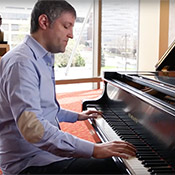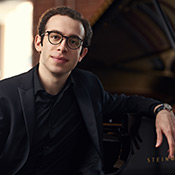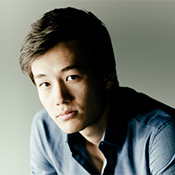
Joyce Yang: An Audience (and Orchestra) Favorite Returns
DAVID LEWELLEN
PUBLISHED
Tagged Under: 2019.20 Season, Guest Artist, piano
Pianist Joyce Yang is well known and well liked by Milwaukee Symphony musicians and audiences, but the novelty in her upcoming concerts will be a new conductor.
Yang is an old hand at Tchaikovsky’s Piano Concerto No. 1, which she will perform with the MSO January 24-26, but she has never worked with conductor Stefan Asbury before.
“We won’t really know each other’s dynamics until we play a concert together,” she said recently by phone from her home in Birmingham, Alabama. “The level of spontaneity changes from person to person at the time of the concert. All the nerves and all the past ideas add up when the audience is in front of us.”
Sometimes a soloist and a conductor don’t see eye to eye – the most notorious example was when Leonard Bernstein announced from the stage that he disagreed with Glenn Gould’s interpretation of the Brahms Piano Concerto No. 1. “I love that clip,” Yang said. But a collaborative approach usually works things out. In the first rehearsal alone with a conductor, “I like being the genie and granting three wishes. Maybe there’s a passage where the conductor wants to bring out the left hand of my part to match the woodwind section, and it’s wonderful. Or I’ll say, ‘Look at me here and we can hold this note together.’”
But in fairy tales, the genie grants only three wishes. “Thirty or forty would be hard,” Yang said, “because we have very limited rehearsal time. We only have time to fix five or six things. The rest is sensing each other’s energy during the concert.”
In the particular case of the Tchaikovsky, “the hard part is the transitions,” Yang said. “In the big passages, people have the same emotions. What’s hard is the little joints, where you have to decide if you’re going to melt into the next section or clip it a little bit.” It would be easier to play the first movement as a collection of vignettes, she said, but a good collaboration will give one arc to the entire piece. And in the third movement, she said, there are so many tempo changes that “every orchestra, I know we’re going to spend three or four times as much time on that. It’s a hard section for everyone.”
Yang has soloed with major orchestras around the world for more than a decade, but she has made repeated visits to Milwaukee. “Every orchestra has a personality,” she said, “and I feel like I know the Milwaukee Symphony very well, since we’ve been on an emotional Rachmaninoff journey together.” Between 2009 and 2014, she played all five of Rachmaninoff’s major piano works with the MSO and former music director Edo de Waart.
“Your specialty is the piece everybody wants to you to play,” Yang said, semi-ironically, but she has been engaged a lot for big, showy Russian pieces. However, de Waart has done German repertoire with her elsewhere, and “I feel like I can do anything with an orchestra like Milwaukee. It’s a very lively group, like great chamber music. All the woodwinds are very soloistic. I know that when I have a duo with some instrument, with each rehearsal, there’s going to be a little more freedom in our interaction, so that we can go a little further from the tempo without ruining it. It’s an orchestra that really breathes.”
“Joyce was very young when she first played with us,” concertmaster Frank Almond said, “but I feel like we’ve watched her evolve into a really great artist. As a person and a pianist, she’s one of my favorites, both to have here as a soloist and to play chamber music together.” If a soloist is invited back, he said, “it’s usually because the orchestra likes them a lot. She has a real rapport with our orchestra and our audience.”
Yang is a busy concert soloist and chamber musician, but in recent years she has been energized by her partnership with the Aspen Santa Fe Ballet, working with dancers and choreographer to create a new piece from the beginning. “It’s not common for the musicians and the dancers to be 50-50,” she said. “I wanted it to be like playing a string quartet. I wanted to know every move the dancers were making, so I lived with them for a month. The sound of the music only came from me. I’m not a recording, and I’m not going to play it exactly the same way ever.” But the adjustment in the moment flows both ways: “If there’s a jump and they’re tired, it’ll be a lesser jump, so my next note needs to come a little earlier.” And the dancers, she said, can illustrate the humor of the music in a way that concertgoers usually miss.
Working that intimately with dancers, she said, “I felt like I was really part of a team for the first time. It’s not like chamber music. That’s more cerebral, like four mailmen delivering the music together. But this must be like what a sports team feels like.”



